June 2, 86 53.45N:73 58.39'W
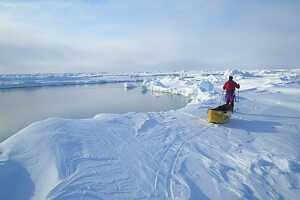
Day 33. The solar radiation heats up our tent to nearly room temperature as we sleep. Sometimes it gets too hot and we have to lay outside our bags - a scary and smelly phenomenon.
We paddled across three leads today and managed to do some filming of the process. We have taken about 7 hours of video so far with more to come. We are hoping to provide some visual documentation of global warming's assault on the Arctic Ocean and its iconic figure, the polar bear.
Our metabolisms are running in overdrive now and we gobble up every last crumb of our daily rations. We have even gone so far as to count our evening crackers to make sure we both get equal share. On the downside, our stomachs are still adjusting to the additional calories.
We thought of another limerick. Hopefully, this one rings a bit more lyrical in all the critics' ears out there.
There once was a pair of long underwear, Whose stench was way beyond compare. On the verge of turning green, In an unpleasant dirty sheen. To the more refined, they smelled of a cheese so rare.
A study in Nature today revealed that, 55 million years ago, the average temperature of the Arctic was 74 degrees F. These findings are proof that too much carbon dioxide - more than four times current levels - can cause global warming, said another co-author, Henk Brinkhuis of Utrecht University.
A special thanks to Kieran Mulvaney, our point man at Greenpeace, for all his hard work. Also thanks for all the positive notes from other Greenpeace folks - you're with us in spirit.
Word of the day: miasma - the source... Our long underwear
June 1, 86 45.56N:73 36.19'W
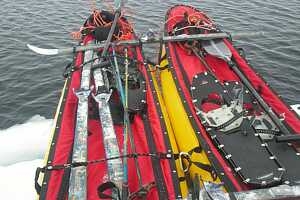
Day 32. Raindrops keep falling on our heads. Raindrops keep falling on our heads and coating our glasses as well as the entire right side of our bodies with ice.
Despite the inclement weather we made great northerly and westerly progress. The ice has once again shown us a new side and we are starting to encounter more large cracks with less brash ice in them. In fact, we had to catamaran the boats five times today.
Paddling across one of the larger leads seemed a lot like being on a lake canoeing back home in Minnesota - except for all the snow and ice, of course.
Part of our research for NSIDC is to measure the freeboard (height above waterline) of the ice at a lead during the day. The process is easy - we just use a ski pole that has a thin meter tape stuck to it. Hopefully, this information can be used to better determine how much the Arctic sea ice is thinning.
As of Day 31, we are 244.2 statute (normal miles) or 212 nautical miles from Cape Discovery (our starting point), and we are 235.8 statute/204.6 nautical miles from the Pole. Pretty exciting if you ask us.
News of the weird: Lonnie's boots have picked up the distinct odor of sour milk. We've done the smell comparison and only Lonnie's boots seem to produce this olfactory mystery.
News of the aging: Eric celebrated his 35th birthday today. There are a few gray hairs (2-5 ONLY) now. No big celebration except for the notable exception of an extra, you guessed it, Clif bar.
Word of the day: redolent - Lon's boots the reminiscence of good milk gone bad.
May 31, 86 35.493N:72 12.30'W
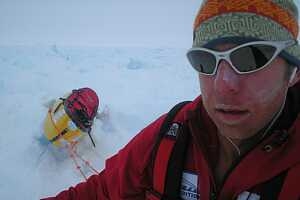
Day 31. The day started with sun but as usual was gone after the first hour of skiing. We had some nice flat pans during this same time. There were few serious obstacles today, with the exception that we had to catamaran the canoe-sleds twice to cross leads.
The ice is becoming better with longer flat stretches giving reason for our record 13 miles. We had a lucky break last night drifting nearly an additional mile north, but east as well. Our hard work moving west has paid off a bit today.
We apologize for not being able to provide you with more heart-stopping X games type action. While exciting at times, our Arctic journey plays out slow and arduous - hardly the stuff for adrenalin junkies. Rather, Arctic explorers are simply doggedly tenacious.
The endless horizon leaves more than enough time for reflection. We are so insignificant here. Pardon us for waxing so poetic, but it just happens. However, now that our artistic side is out in the open, we thought we'd share this limerick with you.
Up here lives an animal called the polar bear. Hiding behind an ice chunk, it would certainly you scare. But what of its fate? When the ice does abate, Will anybody still make an effort to care?
We'll work on something better for tomorrow.
Word of the day: gumption - it's what it takes to keep going every day.
May 30, 86 21.49'N:71 49.30'W
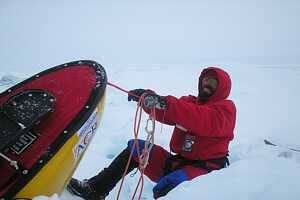
And then it was easy, the weight of the sled-canoes nearly vanished behind us, our legs swishing back and forth effortlessly, smooth unimaginably flat ice for a quarter mile. We stretched our arms out bird-like and pretended to fly. But this was the last 20 minutes of the day; there are nine other grueling hours in this story.
"It was the best of ice; it was the worst of ice," the first line of 'A Tale of Two Pressure Ridges' would most likely read.
Much of the day was spent slowly weaving in and around drifts. The sled-canoes continually yank us off balance as they careen down a slope or slip backwards anchor-like. High stepping to lift ski tips above drifts is an additional burden.
There was also a lot of negotiating large slabs of ice with leads in-between. This process is similar to rock climbing in the sense that each path has a crux - stepping onto unstable brash ice as it sinks, heaving a sled-canoe up a steep embankment, balancing on wedged ice while trying to pull.
The experience is as emotional as it is physical. Observe, plan, anticipate, action, relief. Then again a moment later. Observe, plan, anticipate, action, relief. This time add crisis management because you are sinking into the ocean.
Midday we ran into some decent conditions that allowed us to make a few miles - a total of 11.5 nautical miles, our best yet. But at what price? This was one of our hardest days to date. We feel completely fried in both body and mind. Our legs ache.
We are still drifting east. The wind has abated considerably, but the ice continues to move. We seem to be fighting a losing battle with our endless north-northwesting.
We are continuing to collect data on snow depth and density and ice free board for the NSIDC. Hopefully, this will add to their understanding of how the Arctic ice sheet is melting.
NOAA has predicted an active hurricane season, and is anticipating 10 hurricanes in the North Atlantic this year, of which four to six may become "major" storms.
Word of the day: camellia - something that isn't ice.
May 29, 86 10.14'N:72 46.49'W
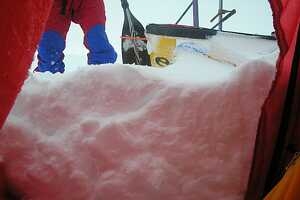
Unzipping the vestibule this morning, we were greeted by a two-foot wall of snow that had covered the leeward side of the tent, sled-canoes, skis, snowshoes and anything else in the vicinity. The snowdrifts from yesterday's storm also disguised dangerous pockets of open water, thin ice, and slush.
Several times, we both had to catch ourselves with our poles to avoid going headlong into the water. We also managed to fall into many of the innumerable cracks we crossed today as they were completely concealed by the new snow.
A stiff southwest wind is pushing us to the east at a pretty good clip. We tried to counter the drift by traveling northwest today, but with limited success. While we slept last night the storm moved our camp nearly a full degree of longitude east. The wind and sun weathered our faces as we fought for 10 hours earning 9 hard-won nautical miles.
We did run into some good ice today, but we didn't use our normal gesture. When the lead skier gets on a huge flat pan, it's usually ski poles in the air 'raise the roof' style. We have developed other language using our ski poles as well. Waving them back and forth means 'Hey, I'm trying to tell you something.' They are also directionals, like 'This route is horrendous, go more to the left.'
Obviously, our Swix ski poles have other purposes. They help us keep balance, catch us on a slip, test the thickness of ice, push the sled-canoes and many others. Skiing or snowshoeing with these poles makes us as stable as a tripod. They rarely leave our hands during the day.
Word of the day: haute couture. Looking good is important out here.
May 28, 86 01.19'N:74 18.14'W

The day seemed to start off nicely with a bit of sun and high wispy clouds. But like the ice conditions, we know that good weather will be followed by bad - or in our case constant overcast. Today turned into the rawest of raw bone devils (see May 18th entry) that we have had to date.
Our morning progressed fairly easily as we made an 'S' around a large lead and pressure. The wind continued much as it had yesterday, blowing in from the southwest. About a half hour before our first sit down break the wind began to pick up.
We huddled behind a chunk of ice to protect us from the biting wind and spindrift as we snacked on, you guessed it, Clif bars. It was a cold break. However, when we hit the trail again 10 minutes later it was really snowing hard, the wind had increased and visibility decreased. We pressed on.
We haven't reported on it much, but we are drifting quite a bit. Most mornings when we check the GPS, our position is slightly off from the previous night. Usually, we drift south (up to a half mile) and east. Last night, we drifted a couple hundred meters north, but also considerably east as well. This is bad because being too far east near the pole means having to fight the normal movement of ice toward the Greenland Sea. So, we've been traveling north-northwest.
The conditions deteriorated so much over the next hour and a half that we felt it necessary to cut our day short. Visibility was down to nearly zero and the snow was blowing hard. It was possible to keep moving, to what we thought might be forward, but at what cost?
We hurriedly set up camp and tried to keep the snow at bay while we unloaded our tent gear into the Hilleberg Hotel. As you can see, the leeward end of the tent was soon plastered with snow. So, here we sit, in relative comfort while a storm rages outside.
But as we wait, we also know that this strong wind is pushing the ice east. Our fate, for now, is largely out of our control.
Amazingly, we made it to the 86th parallel. We looked for our usual snow bunting scout but it must have taken an early hiatus due to the weather.
Check out www.oneworldexpedition.com to see what our amazing expedition manager, John Huston, is up to. We know he's been busy coordinating our resupply.
Word of the day: zephyr - the breeze blowing today... NOT
May 27, 85 54.58'N:75 23.10'W

Right away we labeled the day's travels as a dirty slog. The rest of the day seemed to live up to its moniker. Traversing pressure ridges and leads most of the day in low contrast conditions was laborious at best.
It is a bit awkward not knowing a snowdrift is ahead until you are tripping over the incline. We pushed on as best we could for 10 long hours, our longest travel day thus far.
In other unrelated news, the arctic fox seemed to be paired up and wandering near. It was the second set of dual fox tracks we have seen.
We are now traveling almost directly east of the magnetic north pole and have set an 85 degree west declination to our compass. It seems weird to have the red north needle on our compass point to the west. Equally troubling is the amount of time it takes for the needle to settle. It fluctates back and forth for quite a while until we can shoot an accurate bearing toward true north and the top of the world.
It will be Saturday night when most of you read this. Please have a fun and safe Memorial weekend for us. If we were home in Grand Marais, Minn., what would we do? Perhaps an Uffda-za at Sven and Ole's Pizza, then casually mosey over to the Gunflint Tavern for live music and a pint. But alas, the only way for us is to keep north.
The World Conservation Union (IUCN) has moved the polar bear to its Red List of Threatened Species, classifying the species as "vulnerable" to extinction. Have you added your name to help get the polar bear listed as a threatened species? Thank you very much if you already have.
Word of the day: gammon - a nice big piece please!
